Banafsheh Adami
rPPG-SysDiaGAN: Systolic-Diastolic Feature Localization in rPPG Using Generative Adversarial Network with Multi-Domain Discriminator
Apr 01, 2025Abstract:Remote photoplethysmography (rPPG) offers a novel approach to noninvasive monitoring of vital signs, such as respiratory rate, utilizing a camera. Although several supervised and self-supervised methods have been proposed, they often fail to accurately reconstruct the PPG signal, particularly in distinguishing between systolic and diastolic components. Their primary focus tends to be solely on extracting heart rate, which may not accurately represent the complete PPG signal. To address this limitation, this paper proposes a novel deep learning architecture using Generative Adversarial Networks by introducing multi-discriminators to extract rPPG signals from facial videos. These discriminators focus on the time domain, the frequency domain, and the second derivative of the original time domain signal. The discriminator integrates four loss functions: variance loss to mitigate local minima caused by noise; dynamic time warping loss to address local minima induced by alignment and sequences of variable lengths; Sparsity Loss for heart rate adjustment, and Variance Loss to ensure a uniform distribution across the desired frequency domain and time interval between systolic and diastolic phases of the PPG signal.
GRU-AUNet: A Domain Adaptation Framework for Contactless Fingerprint Presentation Attack Detection
Apr 01, 2025Abstract:Although contactless fingerprints offer user comfort, they are more vulnerable to spoofing. The current solution for anti-spoofing in the area of contactless fingerprints relies on domain adaptation learning, limiting their generalization and scalability. To address these limitations, we introduce GRU-AUNet, a domain adaptation approach that integrates a Swin Transformer-based UNet architecture with GRU-enhanced attention mechanisms, a Dynamic Filter Network in the bottleneck, and a combined Focal and Contrastive Loss function. Trained in both genuine and spoof fingerprint images, GRU-AUNet demonstrates robust resilience against presentation attacks, achieving an average BPCER of 0.09\% and APCER of 1.2\% in the CLARKSON, COLFISPOOF, and IIITD datasets, outperforming state-of-the-art domain adaptation methods.
Advancements in Continuous Glucose Monitoring: Integrating Deep Learning and ECG Signal
Mar 12, 2024
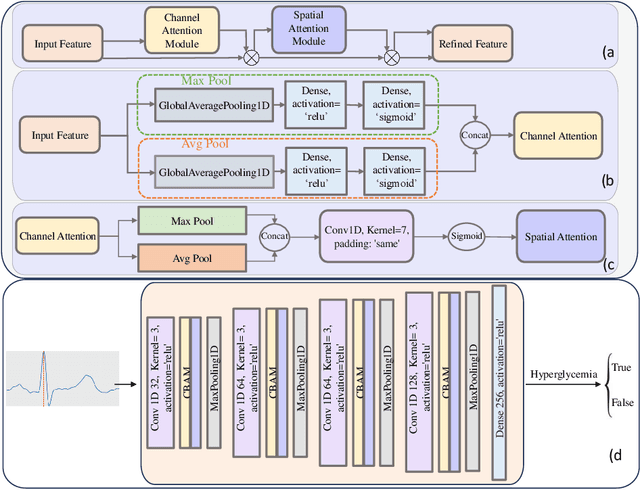
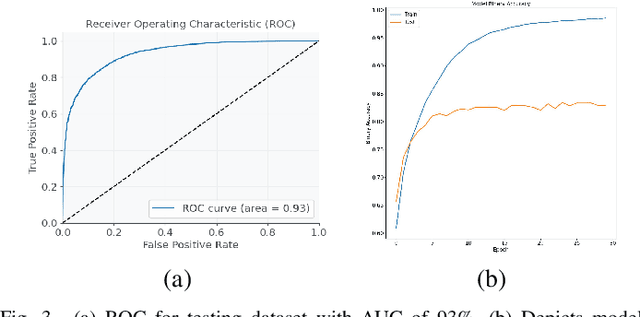

Abstract:This paper presents a novel approach to noninvasive hyperglycemia monitoring utilizing electrocardiograms (ECG) from an extensive database comprising 1119 subjects. Previous research on hyperglycemia or glucose detection using ECG has been constrained by challenges related to generalization and scalability, primarily due to using all subjects' ECG in training without considering unseen subjects as a critical factor for developing methods with effective generalization. We designed a deep neural network model capable of identifying significant features across various spatial locations and examining the interdependencies among different features within each convolutional layer. To expedite processing speed, we segment the ECG of each user to isolate one heartbeat or one cycle of the ECG. Our model was trained using data from 727 subjects, while 168 were used for validation. The testing phase involved 224 unseen subjects, with a dataset consisting of 9,000 segments. The result indicates that the proposed algorithm effectively detects hyperglycemia with a 91.60% area under the curve (AUC), 81.05% sensitivity, and 85.54% specificity.
Contactless Fingerprint Biometric Anti-Spoofing: An Unsupervised Deep Learning Approach
Nov 07, 2023Abstract:Contactless fingerprint recognition offers a higher level of user comfort and addresses hygiene concerns more effectively. However, it is also more vulnerable to presentation attacks such as photo paper, paper-printout, and various display attacks, which makes it more challenging to implement in biometric systems compared to contact-based modalities. Limited research has been conducted on presentation attacks in contactless fingerprint systems, and these studies have encountered challenges in terms of generalization and scalability since both bonafide samples and presentation attacks are utilized during training model. Although this approach appears promising, it lacks the ability to handle unseen attacks, which is a crucial factor for developing PAD methods that can generalize effectively. We introduced an innovative anti-spoofing approach that combines an unsupervised autoencoder with a convolutional block attention module to address the limitations of existing methods. Our model is exclusively trained on bonafide images without exposure to any spoofed samples during the training phase. It is then evaluated against various types of presentation attack images in the testing phase. The scheme we proposed has achieved an average BPCER of 0.96\% with an APCER of 1.6\% for presentation attacks involving various types of spoofed samples.
A Universal Anti-Spoofing Approach for Contactless Fingerprint Biometric Systems
Oct 23, 2023
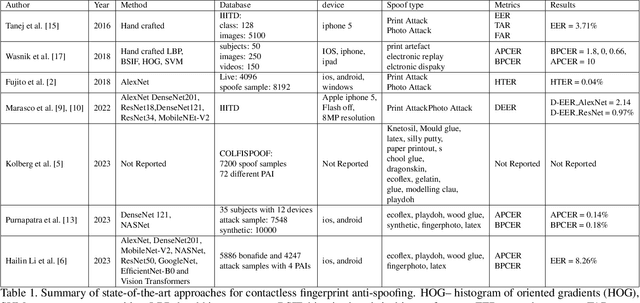
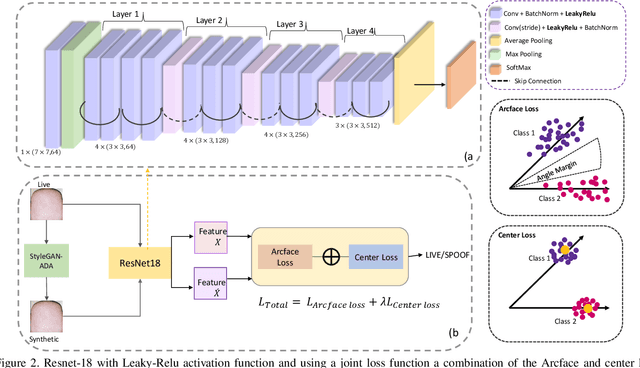
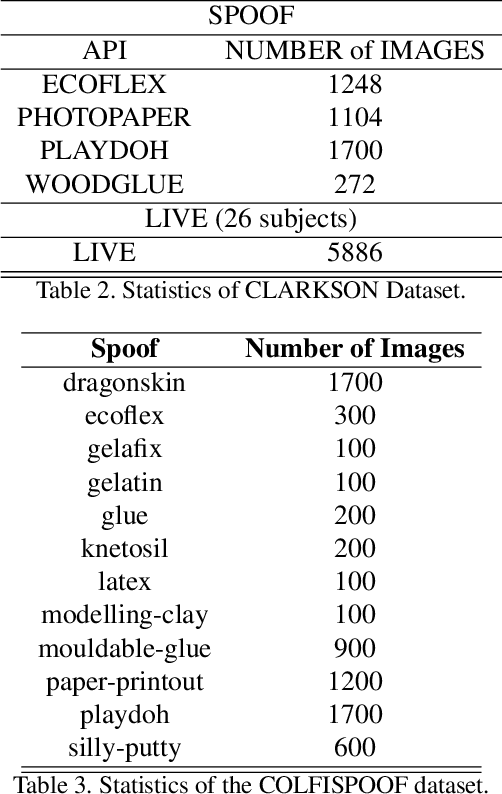
Abstract:With the increasing integration of smartphones into our daily lives, fingerphotos are becoming a potential contactless authentication method. While it offers convenience, it is also more vulnerable to spoofing using various presentation attack instruments (PAI). The contactless fingerprint is an emerging biometric authentication but has not yet been heavily investigated for anti-spoofing. While existing anti-spoofing approaches demonstrated fair results, they have encountered challenges in terms of universality and scalability to detect any unseen/unknown spoofed samples. To address this issue, we propose a universal presentation attack detection method for contactless fingerprints, despite having limited knowledge of presentation attack samples. We generated synthetic contactless fingerprints using StyleGAN from live finger photos and integrating them to train a semi-supervised ResNet-18 model. A novel joint loss function, combining the Arcface and Center loss, is introduced with a regularization to balance between the two loss functions and minimize the variations within the live samples while enhancing the inter-class variations between the deepfake and live samples. We also conducted a comprehensive comparison of different regularizations' impact on the joint loss function for presentation attack detection (PAD) and explored the performance of a modified ResNet-18 architecture with different activation functions (i.e., leaky ReLU and RelU) in conjunction with Arcface and center loss. Finally, we evaluate the performance of the model using unseen types of spoof attacks and live data. Our proposed method achieves a Bona Fide Classification Error Rate (BPCER) of 0.12\%, an Attack Presentation Classification Error Rate (APCER) of 0.63\%, and an Average Classification Error Rate (ACER) of 0.37\%.
Liveness Detection Competition -- Noncontact-based Fingerprint Algorithms and Systems (LivDet-2023 Noncontact Fingerprint)
Oct 01, 2023


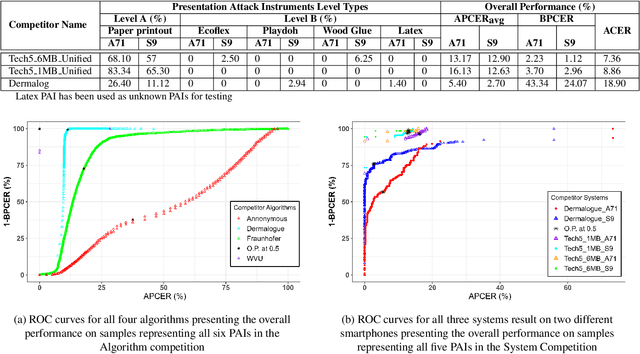
Abstract:Liveness Detection (LivDet) is an international competition series open to academia and industry with the objec-tive to assess and report state-of-the-art in Presentation Attack Detection (PAD). LivDet-2023 Noncontact Fingerprint is the first edition of the noncontact fingerprint-based PAD competition for algorithms and systems. The competition serves as an important benchmark in noncontact-based fingerprint PAD, offering (a) independent assessment of the state-of-the-art in noncontact-based fingerprint PAD for algorithms and systems, and (b) common evaluation protocol, which includes finger photos of a variety of Presentation Attack Instruments (PAIs) and live fingers to the biometric research community (c) provides standard algorithm and system evaluation protocols, along with the comparative analysis of state-of-the-art algorithms from academia and industry with both old and new android smartphones. The winning algorithm achieved an APCER of 11.35% averaged overall PAIs and a BPCER of 0.62%. The winning system achieved an APCER of 13.0.4%, averaged over all PAIs tested over all the smartphones, and a BPCER of 1.68% over all smartphones tested. Four-finger systems that make individual finger-based PAD decisions were also tested. The dataset used for competition will be available 1 to all researchers as per data share protocol
 Add to Chrome
Add to Chrome Add to Firefox
Add to Firefox Add to Edge
Add to Edge